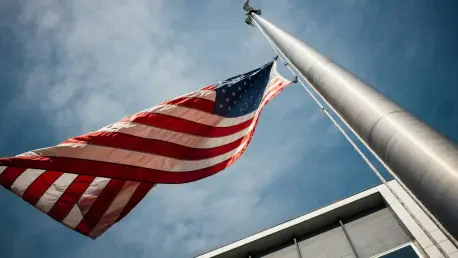In an era marked by rapidly evolving global dynamics, the traditional economic statecraft of the United States finds itself at a critical juncture. Despite wielding profound influence through the unrivaled U.S. financial sector and the dominance of the dollar, the mechanisms by which these tools are utilized need significant overhaul. As adversaries become more sophisticated and the global economy grows increasingly complex, the imperative to modernize economic statecraft becomes evident. The foundations are firm, yet the strategies and institutions responsible for policy implementation have inadequacies that restrict their capacity to fully harness the U.S.’s economic might. In order to seamlessly integrate into the geopolitical tapestry, these methods must evolve as a robust means of national security.
The Importance of Economic Statecraft
Economic statecraft remains an essential pillar of U.S. national security, deeply rooted in the power and reach of its financial sector and currency. The dollar’s status as the world’s reserve currency amplifies the United States’ ability to influence international financial systems and geopolitical landscapes. However, the institutions meant to manage and execute economic policies have not progressed in step with the rapidly changing global environment. This disparity presents a pressing challenge: maintaining the United States’ leadership in global economic governance requires an approach that accommodates current realities. The sinews of economic statecraft, while potent, must be recalibrated to reflect a sophisticated blend of diplomacy, policy innovation, and strategic foresight.
Underpinning the urgency for reform is the recognition that U.S. economic statecraft is not merely an instrument of financial dominance but a strategic asset vital to addressing contemporary security challenges. The interconnectedness of financial networks, the complexities of global trade, and the rise of digital economies necessitate a framework that is agile and responsive. To remain relevant and effective, existing structures must address these multifaceted issues by fostering innovation in policy development and execution. This also involves recognizing and remedying the institutional stagnation that limits the ability of American economic tools to adapt and thrive in a world that demands immediacy and precision in decision-making processes.
Challenges in Current Systems
The challenges at the heart of the United States’ economic statecraft strategy are deeply entrenched within its current systems, particularly in terms of interagency coordination. The lack of cohesion among various governmental agencies results in fragmented decision-making, undermining the holistic application of economic policies. Without a unified approach, the efficiency and efficacy of these strategies are significantly reduced, leaving gaps that adversaries can exploit. This necessitates an introspection of interagency processes to foster cooperation and align efforts across the board, ensuring a well-coordinated front in deploying economic tools.
Furthermore, the institutional apparatus within the Treasury Department requires a substantial overhaul to better address the complexities of modern challenges. The internal processes need rejuvenation to become more agile and responsive, focusing on integrating new methods and technologies capable of handling a rapidly shifting global landscape. Internationally, the roles of the Treasury must also be formalized and empowered to meet the rising expectations and demands of global stakeholders. This includes strengthening diplomatic engagement, expanding the scope of economic intelligence gathering, and enhancing the strategic impact of international financial relationships. Addressing these challenges is crucial for building an effective framework for economic statecraft that aligns with national security objectives.
Technological Integration
Incorporating technological prowess into economic statecraft tools emerges as a pivotal step toward bolstering their efficiency and effectiveness. Advanced technologies, particularly artificial intelligence and sophisticated data analytics, can significantly enhance the precision and agility of economic policies. By processing vast amounts of economic data, these technologies can identify patterns and predict potential adversarial moves, allowing for proactive and strategic responses. The current misalignment between traditional structures and the rapidly evolving technological landscape necessitates a technological renaissance within the Treasury and other relevant agencies. This integration would enable a more comprehensive understanding of emerging global threats and opportunities, thereby reinforcing the United States’ economic influence on the geopolitical stage.
As U.S. adversaries continue to develop sophisticated mechanisms to circumvent traditional financial controls, the need for modernization becomes critical. While traditional responses have relied on sanctions and financial deterrence, there is a growing consensus that revitalizing economic statecraft involves adopting innovative strategies that harness cutting-edge technologies. Leveraging these tools can empower policymakers to design and execute more informed, timely, and targeted economic measures. This approach not only strengthens the nation’s ability to counteract adversarial actions but also enables engagement in crafting favorable economic environments worldwide. Enhancing technological integration within economic statecraft serves as a bulwark against future challenges, positioning the United States to remain at the forefront of global economic governance.
Proposed Reforms
To address the fragmentation within economic statecraft, the establishment of a dedicated economic statecraft and security committee is proposed. Such a committee would be instrumental in harmonizing disparate policies and ensuring synchronized deployment of economic tools. By serving as a central hub for strategic coordination, this body would bring coherence to economic measures and facilitate long-term strategic outcomes aligned with national security interests. The committee’s mandate would encompass overseeing the design and execution of comprehensive economic strategies that are informed by geopolitical, economic, and technological considerations. This systemic enhancement promises to address the current policy fragmentation and elevate the efficacy of U.S. economic statecraft on the global stage.
Additionally, the Treasury’s Office of Intelligence and Analysis is encouraged to redirect its focus towards understanding complex financial interdependencies that impact national security. By prioritizing strategic and nuanced analysis, the office can provide actionable intelligence that bolsters economic policy formulation and implementation. This recommended shift seeks to align economic statecraft with broader national security goals, enabling the United States to deploy economic tools with greater precision and impact. Embracing these policy reforms embodies a commitment to fostering a more informed, agile, and resilient economic statecraft framework that can adeptly navigate the intricate challenges posed by a dynamic global environment.
Enhancing International Roles
The role of Treasury attachés in forwarding U.S. economic policy abroad is underscored as a critical component in modernizing economic statecraft. These positions, stationed within U.S. diplomatic missions, are pivotal in maintaining strategic economic alliances and fostering strong global financial relationships. Congress is urged to take decisive action to formalize and strengthen these roles, ensuring they are seamlessly integrated into the broader fabric of diplomatic efforts. Through enhanced training, clearer mandates, and expanded communication networks, Treasury attachés can effectively advance U.S. economic interests, counteract adverse influences, and build enduring partnerships with international financial policymakers.
Strengthening international roles further involves broadening the scope of their engagements to encompass emerging economic issues and technological developments. By doing so, Treasury officials on the ground can provide timely insights and leverage local connections to influence international economic governance positively. This proactive stance not only reinforces the United States’ position as a leading economic authority but also cultivates an environment where cooperative economic initiatives can flourish. Amplifying the capacity and reach of Treasury attachés aligns with the broader modernization agenda, ensuring that U.S. economic statecraft is not only responsive but also anticipatory in addressing global challenges.
Leveraging Technology
Harnessing advances in technology stands as one of the most pressing imperatives for enhancing U.S. economic statecraft. The Treasury, along with other relevant agencies, is called to embrace artificial intelligence and cutting-edge IT systems to expedite enforcement actions, refine data analysis processes, and improve decision-making timelines. By integrating these technological solutions, the Treasury can accelerate response times to crises, offering a nimble and robust approach to counteracting global threats. This initiative aligns with a broader effort to modernize economic statecraft, transforming how policies are crafted and executed to maximize strategic impact.
The employment of advanced technologies plays a critical role in preemptively identifying potential threats, further enabling U.S. forces to act decisively and effectively. These technological implementations ensure that policy decisions are data-driven and reflective of real-time global economic shifts. By mitigating the information lag and enhancing analytical capabilities, the Treasury positions itself to anticipate and counteract adversaries who deploy innovative and complex strategies. This commitment to technological advancement underscores the need to maintain a proactive posture in economic statecraft, ensuring that the United States remains adaptable and resilient amidst a landscape of rapid evolution and heightened competition.
Urgent Reform Needs
The imperative for reform within the framework of U.S. economic statecraft cannot be overstated. Ensuring interagency cohesion and cooperation emerges as a pivotal strategy for wielding the nation’s economic influence successfully. Effective coordination across departments is essential for deploying comprehensive and strategically aligned economic policies. By establishing clear communication pathways and fostering collaborative efforts, the U.S. can ensure that its economic initiatives reflect a cohesive national strategy. This alignment not only enhances the credibility and impact of economic measures but also positions the United States as a leader in global economic governance.
Moreover, focused intelligence analysis plays a crucial role in crafting informed and impactful economic decisions. It involves a nuanced understanding of global financial dynamics, potential adversarial strategies, and geopolitical complexities. Heightened focus on intelligence gathering and analysis supports the formulation of forward-thinking policies that anticipate challenges and capitalize on opportunities. Diplomatic consistency further supports this agenda, preserving the strength of U.S. economic alliances across the globe. By integrating reforms across these areas, the United States can establish a robust and sophisticated framework for economic statecraft, attuned to the multifaceted challenges of the global economic landscape.
A Forward-Looking Approach
As the discourse shifts towards a future-oriented model, it becomes evident that modernization of U.S. economic statecraft hinges on the embrace of innovative processes and policies. The inherent power of economic instruments extends beyond traditional models to encompass a variety of novel approaches that reflect contemporary realities. This forward-looking perspective underscores the strategic importance of safeguarding American economic power through a multi-dimensional approach. Adopting this mindset involves a commitment to effecting change through thoughtful reforms, technological adaptation, and cohesive policy execution.
Drawing from both established practices and experimental strategies, the proposed changes are intended to fortify U.S. economic command at a time when global dynamics demand adaptability and foresight. By leveraging innovation and fostering interagency collaboration, the U.S. can strategically project its economic strength, influencing economic landscapes and enhancing national security. This proactive stance emphasizes the interplay between economic vitality and geopolitical stability, fostering a resilient framework poised to navigate future uncertainties and challenges. Such an approach reflects a holistic view, recognizing the intricate connections between economic power and comprehensive national security objectives.
Comprehensive Blueprint
Economic statecraft is a crucial element of U.S. national security, deeply intertwined with the power and influence of its financial sector and currency. The U.S. dollar’s role as the world’s reserve currency significantly enhances America’s ability to shape global financial systems and geopolitical dynamics. Despite this strength, the institutions tasked with managing and implementing economic policies have struggled to keep up with the rapidly evolving global landscape. This lag poses a significant challenge: to maintain America’s leadership in global economic governance, a strategy that aligns with contemporary realities is imperative. While the robust framework of economic statecraft remains influential, it requires recalibration to integrate a blend of diplomacy, innovative policy, and strategic foresight.
Underlying the need for reform is the understanding that U.S. economic statecraft serves as more than just a means of financial dominance. It is a strategic resource essential for addressing modern security threats. The interconnectedness of financial systems, the intricacies of global trade, and the advent of digital economies demand a nimble, responsive framework. To stay effective, existing structures must tackle these complex issues by promoting policy innovation and execution. This involves breaking free from institutional stagnation that restricts the adaptability and success of American economic tools in a world where swift, precise decision-making is crucial.









